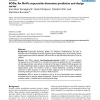Free Online Productivity Tools
i2Speak
i2Symbol
i2OCR
iTex2Img
iWeb2Print
iWeb2Shot
i2Type
iPdf2Split
iPdf2Merge
i2Bopomofo
i2Arabic
i2Style
i2Image
i2PDF
iLatex2Rtf
Sci2ools
BMCBI
2008
2008
SODa: An Mn/Fe superoxide dismutase prediction and design server
Background: Superoxide dismutases (SODs) are ubiquitous metalloenzymes that play an important role in the defense of aerobic organisms against oxidative stress, by converting reactive oxygen species into nontoxic molecules. We focus here on the SOD family that uses Fe or Mn as cofactor. Results: The SODa webtool http://babylone.ulb.ac.be/soda predicts if a target sequence corresponds to an Fe/Mn SOD. If so, it predicts the metal ion specificity (Fe, Mn or cambialistic) and the oligomerization mode (dimer or tetramer) of the target. In addition, SODa proposes a list of residue substitutions likely to improve the predicted preferences for the metal cofactor and oligomerization mode. The method is based on residue fingerprints, consisting of residues conserved in SOD sequences or typical of SOD subgroups, and of interaction fingerprints, containing residue pairs that are in contact in SOD structures. Conclusion: SODa is shown to outperform and to be more discriminative than traditional t...
| Added | 08 Dec 2010 |
| Updated | 08 Dec 2010 |
| Type | Journal |
| Year | 2008 |
| Where | BMCBI |
| Authors | Jean Marc Kwasigroch, René Wintjens, Dimitri Gilis, Marianne Rooman |
Comments (0)

